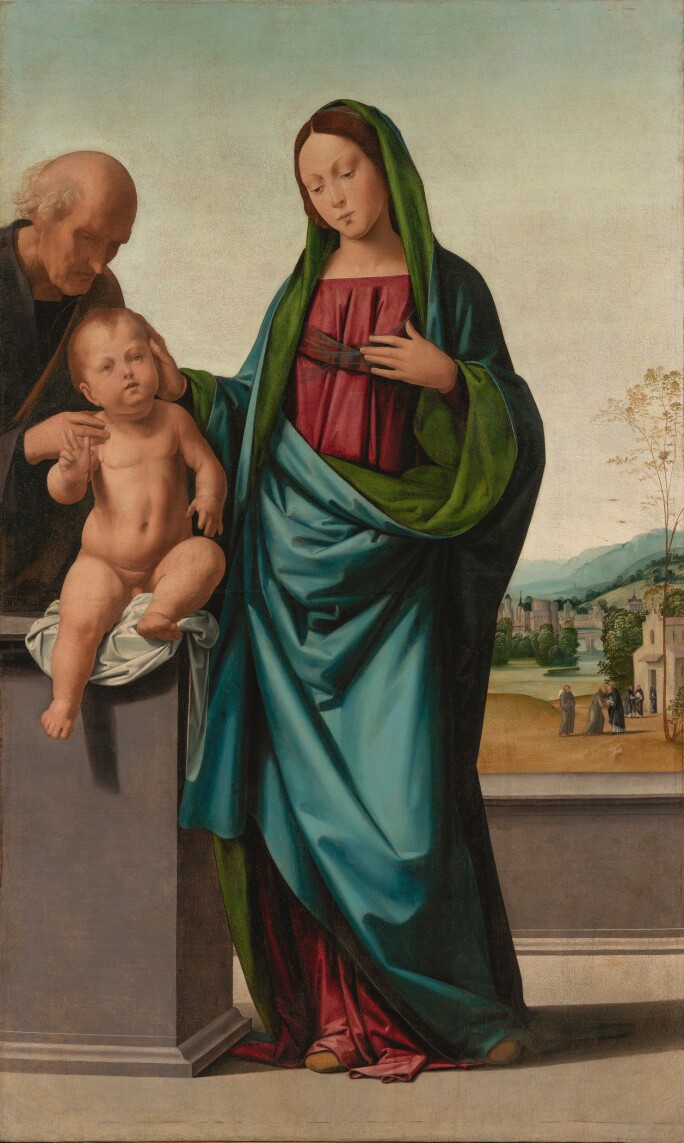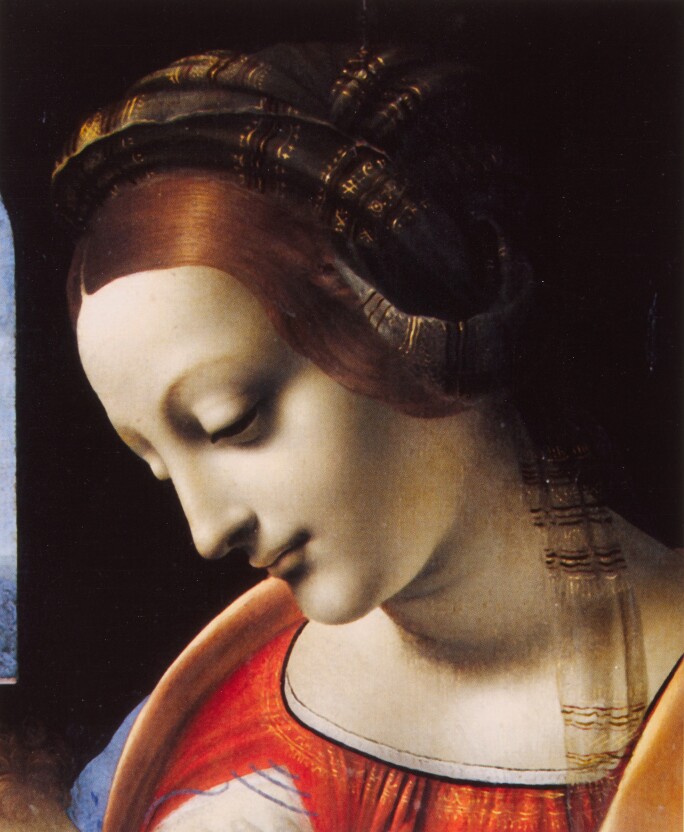This exceptional, rediscovered drawing is a rare idealized portrait study of the head of a young woman, most probably intended as a study for a Madonna. Traditionally attributed to Fra Bartolommeo, it was last seen in public in 1927, when it was acquired by the grandfather of the present owners at a sale in Amsterdam (see Provenance), for the relatively significant sum of 892.50 guilders. We are very grateful to Chris Fischer who has studied the drawing in the original and confirmed the attribution to Fra Bartolommeo, suggesting a date towards the end of the 1490s. The following note is largely based on his observations, and his comparisons with Fra Bartolommeo's extant corpus of drawings.
Carefully and delicately executed, mostly in black chalk and stumping, Fra Bartolommeo’s moving study takes full advantage of the visual possibilities offered by the smooth beige-brown preparation of the paper, a technique that the master often used. The slightly tilted head of the young woman – looking down to the left – is characterized by subtle and delicate volumes, enhanced by the use of the sfumato combined with the rendering of warm sensual skin, achieved by rubbing powdered white chalk into the prepared darker surface. This gives an almost porcelain-like tone to the soft volumes of the face, which acquires an extraordinary luminosity. Moreover, Fra Bartolommeo underlines the effect of vibrating light with delicate touches of white bodycolour,1 for instance on the eyelids and below the eyes, on the tip of the nose and over the chin. These enhance the sense of realism in this beautiful and otherwise idealized face, permeated by a harmonious tranquility. The handling of the black chalk ranges from broader parallel strokes to much freer ones to define the hair, combined with a dense use of the sfumato effect, especially on the right cheek and neck and around the left contour of her face, contrasting in turn with the figure’s very schematic and broadly indicated dress. This variation of stroke and touch focuses the gaze of the observer on the appealing and meditative quality of the young woman’s face, so exquisitely achieved in the rendering of the surface details and the fall of light.
As Chris Fischer has noted, Fra Bartolommeo generally preferred to place his head studies relatively high on the page, as in the present sheet, often leaving almost no space at the top. The image therefore fills the entire page, heightening the emphasis on the figure’s devout, downwards gaze – probably directed towards the new-born Christ Child – and producing an image of intense harmony and religiosity. Fra Bartolommeo must have made his majestic head studies like this one as much as works of art in their own right, as with the intention of using them as studies for a painting or a fresco. In their solidity and sculptural quality they are, though, very much in keeping with the spirit of his ambitious and monumental painted compositions.
Although there are general similarities with Fra Bartolommeo’s paintings from this early part of his career, such as the Holy Family of around 1497, in Los Angeles (fig. 1),2 the present drawing cannot be directly connected with any specific surviving painting by the artist. There are, though, very close parallels with another drawing, Face of a Young Woman and a small sketch of a separate face, from the Fondo Corsini in the Istituto Nazionale della Grafica in Rome.3 Like the present work, that drawing is a rare early head study, and both sheets evince a subtle and less formulaic description of the face, when compared with the more familiar head studies of the artist's late career. As Chris Fischer has observed, 'The suave dreamlike expression seems influenced by Leonardo's female types so I tend to believe that it belongs to the earlier part of Fra Bartolommeo's career'.

In fact, the medium of black chalk was only being used by a very few artists at the end of the Quattrocento, primarily Luca Signorelli (c.1445/50-1523) and Leonardo da Vinci (1452-1519). There is no doubt that in his use of this medium, Fra Bartolommeo was highly influenced by Leonardo, and by painted works such as the Madonna Litta (1491-1495), in the Hermitage (fig. 2, detail of the head of the Virgin), and as the present sheet clearly reveals, he also looked to the example of Leonardo in mastering the sfumato effect to enhance the chiaroscuro. After his early training in the bottega of Cosimo Rosselli (1439-1507), Fra Bartolommeo most surely frequented the workshop of Verrocchio (1435-1488), the most dynamic and progressive artistic center in the whole of Florence which was then under the guidance of Lorenzo di Credi (1459-1537). There he would have many first-hand opportunities to study Leonardo’s original drawings, and acquaint himself with his techniques.

Soon after he made this drawing, Fra Bartolommeo became a novice at the convent of San Domenico in Prato, taking his first vows as a friar on 26 July 1500. Though he did not paint for the next four years or so, he may have continued to draw highly devotional and finished images such as this. These were turbulent, violent times in Florentine history, as the Florentine population came under the spell of the preacher Girolamo Savonarola (1452-1498), also a Dominican friar, who became prior of the convent of San Marco.
An academic and refined draftsman, Fra Bartolommeo typically made numerous drawings at all stages in the preparation of his paintings and frescoed works. These frequently relate to unrecorded projects, sometimes never executed. Among his most attractive and elaborate drawings are these head studies, in his later career often drawn in red and black chalk. The subtle execution of these drawings is testimony to Fra Bartolommeo's skill and confidence in combining media to achieve, as here, a lucid and poetic definition of form. As this sheet abundantly demonstrates, even early in his career, Fra Bartolommeo was master of the technical and artistic finesse required to achieve these effects.
Fra Bartolommeo holds a very distinct and distinguished position among the classic painters of the Renaissance, and over the centuries his works have always been held in high esteem. As early as 1602, his name appears on the list of nineteen artists whose works were banned, by decree of the Grand Duke Ferdinando, from leaving the Grand Duchy of Tuscany without a special export permit. The appearance on the market now of a major, rediscovered drawing by Fra Bartolommeo is, more than four centuries later, an event of considerable significance.
1. In some of his drawings he also employed a yellowish bodycolour
2. Los Angeles County Museum, inv. no. M. 73.83
3. Rome, Istituto Nazionale per la Grafica, inv. no. FC. 124173